
24 Facts on How the Planets were Discovered!
The universe around us
The universe is very old and tremendously gigantic. It extends in all directions for long distances measured by big units called light-years. A light-year is defined as how far light travels in one year. Since the speed of light is 300,000 km/sec, one light year is 9.5 trillion km (that is a very very long distance!)
This enormous space is full of galaxies. Galaxies are full of millions and millions of stars. Each star is a big ball of fire with a powerful gravitational force. This force pulls other space bodies and makes them orbit the star.
We happened to live on top of one of these objects called Earth which orbits a star called the Sun. Many other objects orbit the Sun as well. Scientists then categorized all these objects in one group called the Solar System (sol means sun in Latin).
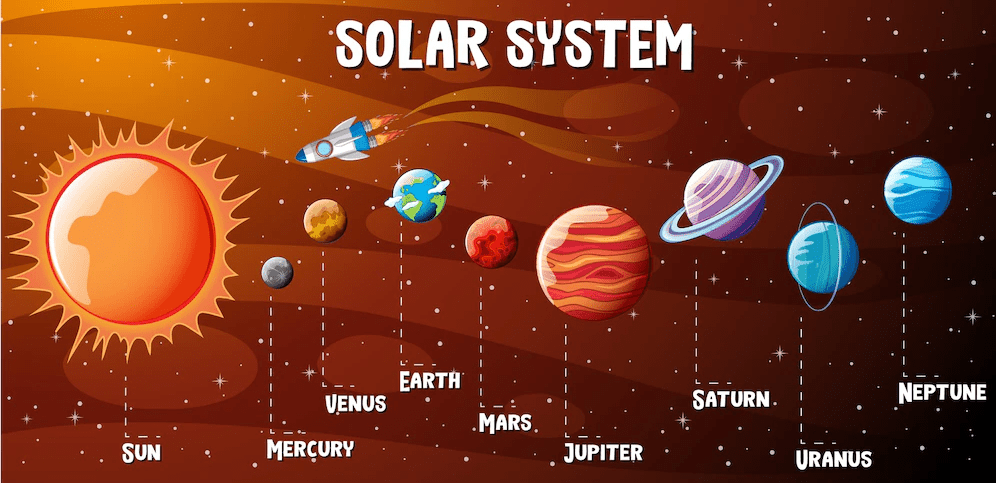
The Sun is the most gigantic object in our Solar System. It comprises 98% of the Solar System’s mass. The remaining 2% of the mass is occupied by all the planets, dwarf planets, moons, asteroids, and comets spinning around the Sun.
Some of these objects, like planets, orbit the Sun directly in almost circular or elliptical orbits. Other objects orbit the Sun indirectly like natural satellites, also known as moons. These moons orbit planets or comets which in turn orbit the Sun.
But how did the Solar System form?
How did planets form?
Well, that is a really interesting story so read closely.
In space, the matter and radiation between star systems are called interstellar medium. A thick region of the interstellar medium that accumulates gas, plasma, and dust is called an interstellar cloud. There are different types of interstellar clouds. One of them is called a molecular cloud.
About 4.6 billion years ago, a giant molecular cloud of hydrogen and helium collapsed. This collapse caused all the mass, which was too hot, to be collected in the center forming the Sun.
In addition, this collapse produced so much dense gas and dust that formed a disc around the Sun. These gassy and dusty particles started to be attracted to one another by gravitational power to form bigger bodies.
Such bigger bodies were later categorized as planets, dwarf planets, asteroids, comets, and moons. There are eight planets in our Solar System. Scientists further classified these eight as inner system planets and outer system planets.
Inner system planets VS outer system planets
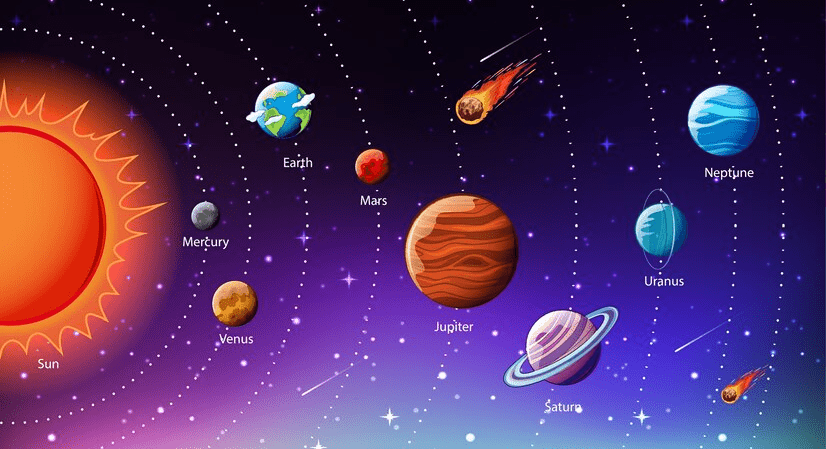
The inner system planets are the four closest planets to the Sun. They are also referred to as terrestrial or rocky planets. These planets are Mercury, Venus, Earth (hello!), and Mars. All of them are composed of silicate rocks or metal.
The outer system planets are also four but gigantic and mostly composed of gas and ice. The largest of the four are Jupiter and Saturn. They are called gas giants because they are composed of hydrogen and helium.
The second-largest ones are Uranus and Neptune. They are so far from the Sun that they are unusually cold. They are composed of ice, not only water ice but also ice of ammonia and methane. And just like the sky makes the ocean look blue, methane also makes those two distant planets blue.
Since it was discovered in 1930 until the early 21st century, Pluto was considered a planet. It was the ninth planet of the Solar System after Neptune. Yet, scientists discovered many other objects. They were either the same size as or bigger than Pluto. So in 2006, the International Astronomical Unit reclassified Pluto as a minor or a dwarf planet.
The inner system planets are the four closest planets to the Sun. They are also referred to as terrestrial or rocky planets. These planets are Mercury, Venus, Earth (hello!), and Mars. All of them are composed of silicate rocks or metal.
The outer system planets are also four but gigantic and mostly composed of gas and ice. The largest of the four are Jupiter and Saturn. They are called gas giants because they are composed of hydrogen and helium.
The second-largest ones are Uranus and Neptune. They are so far from the Sun that they are unusually cold. They are composed of ice, not only water ice but also ice of ammonia and methane. And just like the sky makes the ocean look blue, methane also makes those two distant planets blue.
Since it was discovered in 1930 until the early 21st century, Pluto was considered a planet. It was the ninth planet of the Solar System after Neptune. Yet, scientists discovered many other objects. They were either the same size as or bigger than Pluto. So in 2006, the International Astronomical Unit reclassified Pluto as a minor or a dwarf planet.
And then what?
In fact, there are many other bodies in the Solar System. They might not be as large as planets but definitely as marvelous. For example, asteroids.
Asteroids
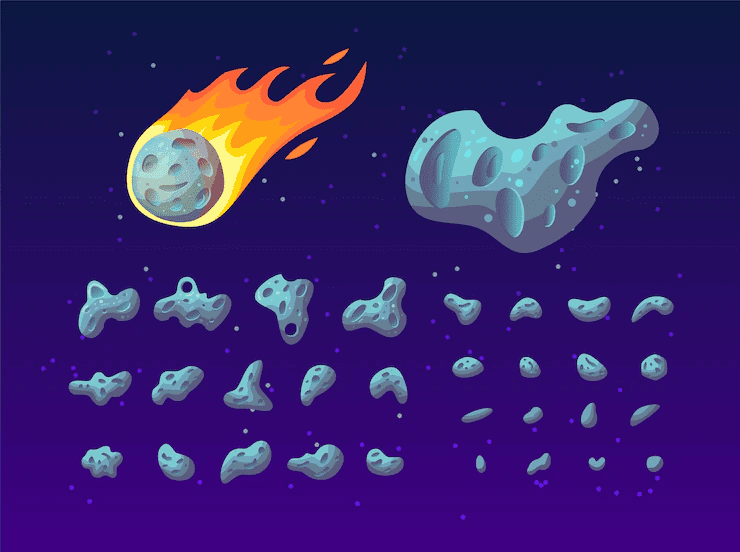
Besides the eight known planets, there are many, so many that we cannot even count them, other smaller rocky bodies called asteroids. They are not round but they have irregular shapes.
Asteroids can be very large or very small. For example, the diameter of the largest asteroid ever found, Vesta, is 525 km. That is almost the distance between London and Belfast! However, the smallest asteroid scientists discovered is about 10 meters across.
The largest collection of asteroids in our Solar System, about 1.1 to 1.9 million, is found in the space between Mars and Jupiter. This collection is defined as the asteroid belt. These millions of asteroids orbit the Sun too.
Just like the asteroid belt, there is the Kuiper belt right behind the orbit of Neptune. This Kuiper belt is different from the asteroid belt. Its objects are mostly composed of ice because they are very very far from the Sun. Pluto in fact lives in the Kuiper belt along with many similar brothers of objects.
Besides the eight known planets, there are many, so many that we cannot even count them, other smaller rocky bodies called asteroids. They are not round but they have irregular shapes.
Asteroids can be very large or very small. For example, the diameter of the largest asteroid ever found, Vesta, is 525 km. That is almost the distance between London and Belfast! However, the smallest asteroid scientists discovered is about 10 meters across.
The largest collection of asteroids in our Solar System, about 1.1 to 1.9 million, is found in the space between Mars and Jupiter. This collection is defined as the asteroid belt. These millions of asteroids orbit the Sun too.
Just like the asteroid belt, there is the Kuiper belt right behind the orbit of Neptune. This Kuiper belt is different from the asteroid belt. Its objects are mostly composed of ice because they are very very far from the Sun. Pluto in fact lives in the Kuiper belt along with many similar brothers of objects.
So, what did our ancestors think about the Solar System?
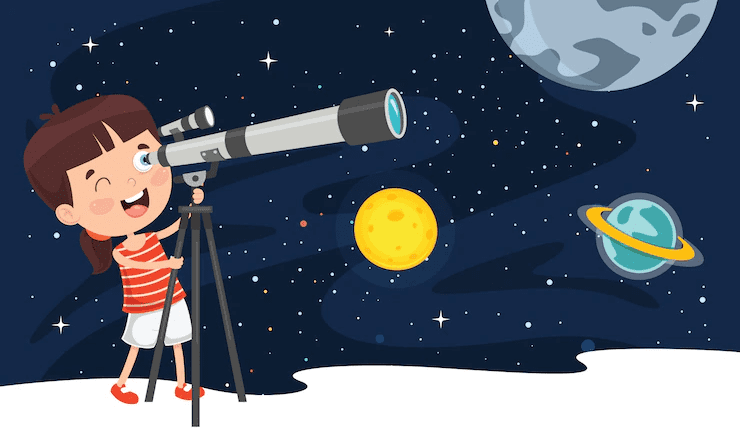
Since the beginning of life on Earth, humans have been interested in exploring space. Ancient civilizations like Egypt and Babylon studied the stars and planets. They took measurements to determine festivals and the hours of the night.
However, people throughout history always believed that Earth was the center of the universe. They imagined it floating motionless while other planets and stars spun around it.
Perhaps one of the earliest true assumptions ever made about the Solar System was that by the ancient Greek mathematician and astronomer Aristarchus of Samos (born in 310 BC). He presented a model that placed the Sun in the middle while Earth and other space objects revolved around it.
Unfortunately, Aristarchus was not believed much. This is because other great philosophers such as Aristotle thought he was wrong. And since the public extremely trusted Aristotle, they did not believe Aristarchus as well.
Starting the 15th century, many astronomers and mathematicians from different regions across Europe began to explore the sky, planets, and stars. They developed different theories that later proved Aristarchus right.
It is so interesting to mention here that all these incredibly intelligent astronomers made their assumptions about the Solar System mostly by using mathematics. They barely looked at the sky. Well, even if they did, they would only see teeny-tiny twinkling bulbs and nothing more.
And this is when telescopes came into existence.
The story of telescopes
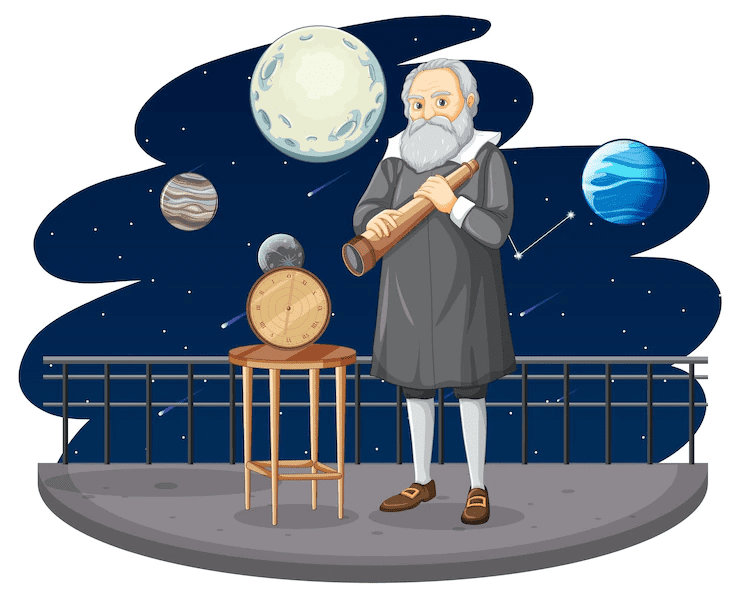
In 1608, a Dutch eyeglass maker invented an instrument that could magnify objects three times. A year later, an Italian astronomer—who would become very known after that—heard about this invention. So he made one for himself that could magnify objects 20 times.
This Italian astronomer was Galileo Galilei. Because he was so interested in space, Galileo started pointing his 20-time magnifying optical instrument towards the sky. Later on, this instrument took the name of the telescope.
Using his telescope, Galileo could make different observations of objects in the sky. For example, he observed Earth’s moon and the transits of Venus. He also discovered that Jupiter, the biggest planet in our Solar System, had four moons.
Galileo then used these observations to claim that the Sun was the center of the Solar System, not Earth and that all other planets orbited it.
But once again, Galileo was not believed; this time by the Catholic Church as well as thousands of people. Those people only accepted the model in which Earth was at the center of the sky. So, the Church considered Galileo’s model against religion.
Sadly, Galileo was arrested and kept in his house as a prisoner. Nine years after his arrest, he died.
Luckily, Galileo’s observations did not die with him. Many astronomers followed in Galileo’s footsteps. They could prove mathematically and telescopically that the Sun is in the middle and that other planets and sky bodies orbit it. This fact was later given the name we are all familiar with: the Solar System.
How were planets discovered?
So far, we have learned about the Solar System as a whole. We understood what our ancestors thought about it. We also found out how the great astronomers of the past proved the Sun is in the middle of the sky.
Now let’s learn about how each planet was discovered.
Mercury and Venus are two planets that can be spotted in the sky with the naked eye. Ancient people knew about and mentioned them in their rocky journals. But Galileo (remember him from above?) was the first person to observe both Mercury and Venus through a telescope. That was in the early 17th century.
During the next two centuries, many other astronomers could observe both planets using more accurate telescopes. Such observations enabled them to study Mercury’s surface features and Venus’s phases and atmosphere. Astronomers could also calculate Mercury and Venus’s day and year lengths.
Mars, Jupiter, and Saturn were also known in prehistoric times. Galileo (yes, again) could observe Mars with his telescope in 1610. In the same year, Galileo observed the four largest moons of Jupiter. These moons, as a group, were named after him: Galilean moons.
Yet, Galileo’s simple telescope could not observe Saturn accurately. But in 1655, a Dutch astronomer called Christiaan Huygens using a more advanced telescope saw Saturn’s rings and one of its moons.
So far, we have learned about the Solar System as a whole. We understood what our ancestors thought about it. We also found out how the great astronomers of the past proved the Sun is in the middle of the sky.
Now let’s learn about how each planet was discovered.
Mercury and Venus are two planets that can be spotted in the sky with the naked eye. Ancient people knew about and mentioned them in their rocky journals. But Galileo (remember him from above?) was the first person to observe both Mercury and Venus through a telescope. That was in the early 17th century.
During the next two centuries, many other astronomers could observe both planets using more accurate telescopes. Such observations enabled them to study Mercury’s surface features and Venus’s phases and atmosphere. Astronomers could also calculate Mercury and Venus’s day and year lengths.
Mars, Jupiter, and Saturn were also known in prehistoric times. Galileo (yes, again) could observe Mars with his telescope in 1610. In the same year, Galileo observed the four largest moons of Jupiter. These moons, as a group, were named after him: Galilean moons.
Yet, Galileo’s simple telescope could not observe Saturn accurately. But in 1655, a Dutch astronomer called Christiaan Huygens using a more advanced telescope saw Saturn’s rings and one of its moons.
What about Uranus?
Just like his planetary neighbors, Uranus was observed in prehistoric times but it was mistaken for a star. Then in the late 17th century and the mid 18th century, multiple astronomers observed Uranus at least 18 times.
One day in March 1781, British astronomer Sir William Herschel was observing the sky from his garden. Using his telescope, he spotted an object. At first, he thought this object was either a Nebulous star or a comet. But he later defined it as a comet. Then again, Herschel thought that the object he discovered was either a comet or a planet.
Later, Finnish-Swedish astronomer Anders Johan Lexell discovered that the new object had a nearly circular orbit, like planets. But comets have an overly elliptical orbit. So the new object was internationally identified as a planet.
Just like his planetary neighbors, Uranus was observed in prehistoric times but it was mistaken for a star. Then in the late 17th century and the mid 18th century, multiple astronomers observed Uranus at least 18 times.
One day in March 1781, British astronomer Sir William Herschel was observing the sky from his garden. Using his telescope, he spotted an object. At first, he thought this object was either a Nebulous star or a comet. But he later defined it as a comet. Then again, Herschel thought that the object he discovered was either a comet or a planet.
Later, Finnish-Swedish astronomer, Anders Johan Lexell discovered that the new object had a nearly circular orbit, like planets. But comets have an overly elliptical orbit. So the new object was internationally identified as a planet.
And Neptune?
We learned that Galileo observed Mercury, Venus, Mars, and Jupiter. He also spotted Neptune with his telescope. Galileo observed Neptune twice on 28 December 1612 and on 27 January 1613. However, he did not think it was a planet. He thought it was a stationary star.
One day in 1821, the French astronomer Alexis Bouvard published astronomical tables about Uranus’s orbit. Such tables contained data that facilitated the calculation of Uranus’s position and its planetary calendar.
However, when Bouvard observed Uranus with a telescope, he saw something strange. Uranus’s orbit experienced some changes. These changes caused the orbit to deviate from the perfect circle shape. That meant Bouvard’s data and the real data from the orbit were unmatching.
So Bouvard assumed that Uranus was subject to gravitational force from a mysterious planet. More than 20 years later, two other astronomers called John Couch Adams and Urbain Le Verrier used Bouvard’s observations to predict, with mathematical calculations, the position of that mysterious planet.
In September 1846, German astronomer Johann Gottfried Galle was able to observe Neptune using an advanced telescope. His observation almost matched the calculations made by Urbain Le Verrier.
It is interesting to mention here that Galileo recorded his observations as drawings. In them, there were some plotted points in a position. When Galle later discovered Neptune, he found out that those dots in Galileo’s drawing were in the same position as that of Neptune.
Galileo was the first to observe Neptune but he never knew that.
How did planets get their names?
Now we are quite familiar with the concept of the Solar System and its second most popular inhabitant, the planets. We learned about how and by whom they were discovered. Now let’s discuss how each planet got its name. There are some interesting stories so let’s take them one by one.
Mercury
Before Mercury became the name of the closest planet to the Sun, it was the name of a Roman god which people worshiped many many centuries ago. The god Mercury was actually a messenger. He could travel very quickly delivering messages from here to there among other gods.
On the other hand, Mercury, the planet, is the fastest in the Solar System. Being very close to the Sun means the planet is subject to a huge gravitational pull. This pull in return causes the planet to orbit the Sun very fast. In fact, Mercury travels around the Sun in only 88 days. That is even shorter than winter in Ireland!
So, the fastest planet was named after the fastest Roman god, Mercury. Makes sense.
Before Mercury became the name of the closest planet to the Sun, it was the name of a Roman god which people worshiped many many centuries ago. The god Mercury was actually a messenger. He could travel very quickly delivering messages from here to there among other gods.
On the other hand, Mercury, the planet, is the fastest in the Solar System. Being very close to the Sun means the planet is subject to a huge gravitational pull. This pull-in return causes the planet to orbit the Sun very fast. In fact, Mercury travels around the Sun in only 88 days. That is even shorter than winter in Ireland!
So, the fastest planet was named after the fastest Roman god, Mercury. Makes sense.
Venus

With Venus, things start to get a little different (and interesting.)
Although Mercury is closer to the Sun, Venus is much hotter. In fact, Venus is hotter than any other planet in the Solar System. This is because Venus is covered in clouds and its very thick atmosphere is full of carbon dioxide. This gas creates the well-known greenhouse effect. Such an effect keeps the heat inside and prevents it from escaping to space.
In addition, these clouds reflect the light coming from the Sun. That is why Venus always looks as bright as the Moon. But Venus looks tinier than the Moon of course because it is further from Earth.
As Venus is so beautifully bright, well the brightest of all planets, it was given the name of the Roman goddess of beauty and love. Interestingly, Venus can be seen with the naked eye to the east before sunrise or in the west during the evening.
Earth
Earth, also known as home.
When it comes to naming Earth, we do not really seem to know a lot about it. All we know is that the word earth came from English/German origins which means the ground.
Maybe because it is the only planet suitable for life?
Mars
Way before Mars referred to a 51g-nougat-caramel-almondless chocolate bar, it was the name of the Roman god of war.
Meanwhile, planet Mars was found to be red. Scientists attributed its red color to the fact that Mars’s surface is full of iron oxide. Iron oxide is a red chemical composed of iron and oxygen. It gives Mars the red color. It is also the same chemical that gives blood and rust their reddish color.
Since blood is associated with war, the fourth planet from the Sun was then named after the Roman god of war, Mars.
Jupiter
Jupiter is the giant of the giants and the second biggest body in the Solar System. It is so big that it is 11 times wider than the earth. To easily get that, imagine a coin is Earth then place 11 such coins beside one another. They would make the diameter of a much bigger circle. This bigger circle is Jupiter.
Naming Jupiter was no big deal at all. The gigantic planet got its name from the Roman king of gods, Jupiter, who was in charge of all aspects of life in Roman religion.
Saturn
Known for its incredibly beautiful rings, Saturn is the second biggest planet after Jupiter. It is also the third biggest body in the Solar System. Saturn got its name from Roman mythology. It was named after the Roman god of wealth, agriculture, and harvest.
Uranus
We learned that Sir William Herschel was the astronomer who discovered Uranus. And just like we get to name a kitten we adopted, Herschel was asked to name the planet he discovered. So he named it after King George III who ruled Britain back at the time.
Yet, such a name was only popular in Britain and not in the rest of the world. So many other names were then proposed. But seventy years later, the seventh planet in the Solar System was finally given the name of Uranus. Uranus was the Greek god of the sky.
Neptune
Neptune is often described as Uranus’s near-twin. It is the eighth planet in the Solar System. Neptune is also the bluest, densest, and furthest planet from the Sun.
Naming Neptune is an interesting story to know. At first, it was called the planet exterior to Uranus or Le Verrier’s planet. Then astronomers began suggesting different names such as Janus and Oceanus. These were Roman and Greek gods’ names.
Neptune was known to be the god of the sea in Roman religion. Astronomers wanted to keep with the previously named planets in the Solar System. That is why they called the eighth planet Neptune.
How many orders can we put planets in?
We are now familiar with the planets in our Solar System. We learned about how planets were discovered and how they got their names. We also learned some interesting facts about planets such as Venus’s brightness.
By default, planets are classified according to their distance from the Sun. This order goes like this: Mercury, Venus, Earth, Mars, Jupiter, Saturn, Uranus, and Neptune. Yet, we can also arrange planets in order of heat, size and mass, orbital speed, and day length. Let’s explore them one by one.
Planets in order of heat
It is very rational to think that the closer a planet is to the Sun, the hotter it is. But this does not apply to two of the planets in our Solar System: Venus and Uranus.
As we previously explained, Venus’s atmosphere is full of carbon dioxide. This gas keeps the heat inside and prevents it from escaping to space. This makes Venus hotter than any other planet in the Solar System.
Similarly, we would think that Neptune is colder because it is further from the Sun than Uranus. In fact, it is the other way around. The coldest temperature ever found on Uranus was -223.8 °C which beats Neptune’s coldest temperature -210 °C. Here is how this happens.
Every planet has an axis. Scientists found that each planet also tilts a certain degree. While Earth’s tilt is 23 degrees, Uranus’s tilt is 98 degrees! This makes Uranus look like it has been knocked over and is rotating on its side.
This tilted rotation is believed to cause Uranus to never retain the heat coming from its core. It escapes perpetually to space. This causes Uranus to be very cold, even colder than its brother Neptune.
So when we put planets in order of heat, they go like this: Venus, Mercury, Earth, Mars, Jupiter, Saturn, Neptune, and Uranus.

Planets in order of size
This is another order when planets take different positions than that of the distance from the Sun.
Mercury happens to be the smallest planet in the Solar System with a radius of 2.4 km.
The second smallest planet is Mars with a radius of 3,389.5 km. Scientists believe that Mars has become so small because of the gravitational pull of Jupiter, its giant neighbor. Jupiter’s gravity caused Mars’s small size while it was forming billions of years ago.
Some planets are very close in size like Venus with a diameter of 6,051.8 km and Earth with a diameter of 6,371 km. It is the same case with Uranus, 25,362 km in radius, and Neptune, 24,622 km in radius. Each pair of these planets is called near-twins.
Now, putting planets in order of their size would come up this way: Mercury, Mars, Venus, Earth, Neptune, Uranus, Saturn, and Jupiter. This is also the same planet arrangement in order of mass.

Planets in order of orbital speed
Orbital speed is how fast a planet orbits the Sun. Every object in the Solar System is attracted to the Sun by its gravitational pull. That means, the closer an object is to the Sun, the stronger the Sun’s gravitational pull. This also means that the stronger the gravitational pull on a planet, the faster the planet revolves around the Sun.
Such orbital speed also determines how long a planet takes to complete one orbit around the Sun. This is called the solar year. So when a planet is fast, it takes a short time to orbit the Sun. So, fast planets have short solar years, and vice versa.
That is why Mercury is the fastest planet with an orbital speed of 47.36 km/s. Mercury also has the shortest solar year of 88 earth days. Likewise, Neptune is the slowest planet. It goes around the Sun at a speed of 5.43 km/s. That is why Neptune’s solar year is the longest. It is equal to 60225 earth days (Earth’s solar year as you know is 365.25 days)
So, planets in order of their orbital speed are: Mercury, Venus, Earth, Mars, Jupiter, Saturn, Uranus, and Neptune. This is also the same planet arrangement when put in order of their distance from the Sun.

Planets in order of day length
Three paragraphs ago, we defined a solar year as the period taken by one planet to complete one revolution around the Sun. A planet takes one whole day to complete one rotation around its axis.
And this is where the fun begins! When it comes to putting planets in order of their day length, things get a little jumbled. For example, Jupiter completes one rotation around its axis in only 10 hours. Then comes Saturn with 10 hours and 42 minutes, Neptune with 16 hours and 6 minutes, and Uranus with 17 hours and 14 minutes.
We know that Earth’s day lasts 24 hours. That means the giant planets of the Solar System have shorter days than that of Earth. In sixth place, we have Mars with 24 hours and 37 minutes. After that is Mercury whose day equals 58 earth days, 15 hours, and 30 minutes.
In eighth place, we have Venus whose day equals 243 earth days! This is quite insane, you know why? Because Venus’s year is 224 earth days! Venus’s year is shorter than its day! And this is because Venus travels around the Sun faster than it rotates around itself.
So planets’ arrangement in order of their day length comes like this: Jupiter, Saturn, Neptune, Uranus, Earth, Mars, Mercury, and Venus.

All in all
After we have learned about the different orders in which we can put the eight planets of our Solar System, here’s a table vision of them all.
| Distance from the Sun (closest to furthest) | Heat (hottest to coldest) | Size, diameter, and mass (smallest to biggest) | Orbital speed (fastest to slowest) | Year length (shortest to longest) | Day length (shortest to longest) |
|---|---|---|---|---|---|
| Mercury | Venus | Mercury | Mercury | Mercury | Jupiter |
| Venus | Mercury | Mars | Venus | Venus | Saturn |
| Earth | Earth | Venus | Earth | Earth | Neptune |
| Mars | Mars | Earth | Mars | Mars | Uranus |
| Jupiter | Jupiter | Neptune | Jupiter | Jupiter | Earth |
| Saturn | Saturn | Uranus | Saturn | Saturn | Mars |
| Uranus | Neptune | Saturn | Uranus | Uranus | Mercury |
| Neptune | Uranus | Jupiter | Neptune | Neptune | Venus |
Did you notice how many orders are the same?
Conclusion
In this article, we discussed how the Solar System formed. We learned about the different space bodies that orbit the Sun. We also studied planets in a bit of detail.
After that, we learned the astounding story of the planets’ discovery. Italian astronomer Galileo made great contributions in discovering Mercury, Venus, Mars, Jupiter, and Neptune. We also understood where each planet got its name and how those names are related to the features of the planets.
Lastly, we demonstrated five different orders to arrange the planets. These orders gave us multiple interesting information about the planets. For example, Neptune has the longest year and Venus has the longest day.
The Solar System is as mysterious as it is enchanting. Humans have always looked at the sky and wondered what those teeny-tiny sparkles were. This curiosity has inspired astronomers to work hard and explore the Solar System.
So every time you see the Moon in the night sky or use your school telescope to spot Jupiter, or go to a stargazing spot during a meteor shower in summer, remember all those great astronomers who devoted their lives to exploring the Solar System and tell us about the enchanting universe we are floating in.


Leave a Reply